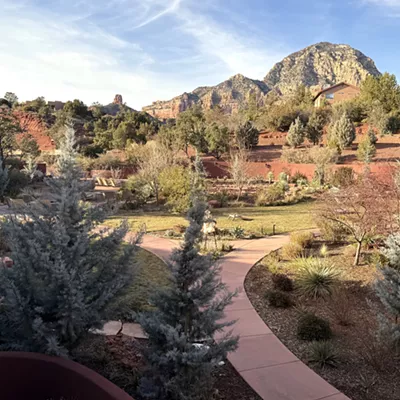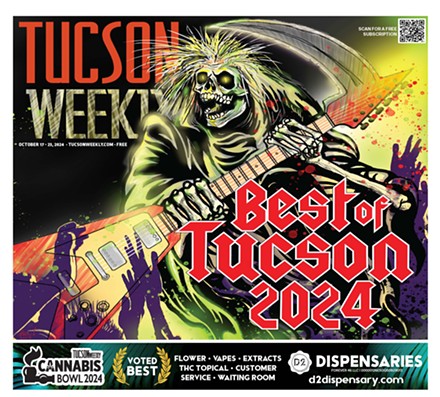Whatever it was, it profoundly changed my life, and I'd like to think the end result added something special to the fabric of this tortured little burg we love to call home.
When the first issue appeared on Feb. 22, 1984, it was the culmination of years of longing on the part of the two founders. Hometown boys who decided to stay here after graduating from the UA, we were passionately in love with this place and with publishing. What better way to combine those affections than to create a vehicle to convey to the community why it needed to give a damn? Or as the Weekly's erstwhile columnist Jeff Smith once declaimed in regard to our early efforts: Hey, kids, let's start a newspaper!
Our underlying purpose--apart from the personal ads and the comix, of course--was to celebrate the good, challenge the conventional wisdom and raise hell with those who would denigrate--either through greed, incompetence or plain stupidity--that which makes this corner of the Sonoran Desert such a unique place. Whether or not we succeeded--at least under my watch--is entirely up to you, dear reader, but we had a lot of fun trying, and we produced a paper that we ourselves wanted to read. Most of the time, that was all that mattered.
That the newspaper exists at all 20 years hence is no small miracle. Having graduated a year and half before, we had both been involved in previous publishing endeavors, most notably the short-lived Coyote, a nonprofit journal devoted to a bioregional ethic of environmental and cultural sustainability. When that noble effort failed, we set about to create a more economically viable publication, modeled after successful alternative weeklies in larger cities. The alt-weekly is now a ubiquitous fixture in even the smallest urban areas, but at the time, the industry was still young, evolving and somewhat on the edge.
We embarked with $5,000 borrowed from a few friends, rented a tiny office in Barrio Viejo, bought a typewriter on credit (this was before the widespread use of the personal computer), hired a single employee and started selling ads. The rest, as they say, is an endless series of anecdotes and recollections, not to mention boxes and boxes of neatly organized back issues moldering in my storage room.
Numerous interventions of the seemingly divine kind kept the Tucson Weekly going those first five years, including an accounting snafu at our first printer that, unbeknownst to them, netted us more than $100,000 in financing during those first fevered months (let the record show that we reached a satisfactory settlement out of court with this very large national company); the generosity of a small group a shareholders who thought they were donating money to a lost cause but did it anyway; gracious family members who loaned us money numerous times when the wolf was at the door; and the involvement of a notable angel, Sidney Brinckerhoff, who stepped in at the paper's darkest hour--when the two founding partners split in a bitter dispute after five years--and wrote the first of several six-figure checks.
It was Sid's faith and patience that allowed me to finally figure out how to run the business while adhering to an unwavering commitment to produce a quality publication that wasn't solely focused on the bottom line. If you enjoy this paper, you owe Sid Brinckerhoff a debt of gratitude.
The love thang also extended to the culture that grew up around the Weekly. Over the 16 years that I was its publisher, I had the great fortune to work with many special people who gravitated to the Weekly's mission and devoted their own passion to the cause in ways and with an intensity that still amazes me.
As with any family, we had occasional disharmony, and I'm sure there are numerous former employees and contributors who would dispute my rosy recollections; but by and large, we developed a loyal and committed staff that had an extraordinary alchemy. There was a palpable level of energy and enthusiasm that transcended the low salaries and long hours, creating magic on the pages week after week. I would often take an issue home on publication day, sit at the kitchen table into the night and marvel at the quality produced by insanely devoted people working with limited budgets, in cramped spaces and under the leadership of a publisher who often changed his mind in midstream, often at the last minute (or who simply couldn't make up his mind at all). Many Weekly alumni moved on to larger cities and bigger paychecks, but a core of talented people stuck with me for more than a decade, and I'm profoundly grateful for that.
So if it was such a wonderful experience, all lovey-dovey and such glorious fun, why in the hell did I up and sell the paper in the spring of 2000 to Wick Communications? It's a question I still can't answer with sufficient gravitas. On one level, I realized that after 20 years of publishing, I had done what I set out to do. Maybe it was 16 years of chasing every dollar to make sure each payroll was met and the printer got paid. Or the toll of too many late nights and lost weekends poring over spreadsheets and fretting over budgets. Perhaps, in the end, my eternal struggle to balance my never-too-acute business acumen with the dictates of my heart began to weigh on me. Or maybe, after nearly 20 years of pushing millions of tons of newsprint and ink onto the streets of Tucson, I had simply burned out.
So with much regret, the love thang was commoditized, a fair price determined in exchange for giving up my coveted identity as publisher of Tucson Weekly, and I walked away from all that. I had finally acknowledged one of my prime dictums: No one is indispensable. The Tucson Weekly went on without me. And so it does.
It's amazing what a couple years off will do for you.
Having worked with a group of committed people to create a vehicle for community and to engender an ongoing dialogue about what it means to live here, I've found a new calling that allows me to replicate that experience, but in a different context. I find it equally exciting--and the challenges to be as fascinating--as running an independent newspaper in a media world almost entirely dominated by rapacious corporate ownership and ever-increasing consolidation.
My new mission is pretty straightforward: Once and for all, it's time to revitalize Downtown Tucson. And once again, I find myself working with an insanely dedicated group of talented individuals who are determined to see a vision become a reality in the face of nay-sayers who say it can't be done.
And in the end, it comes back to the love thang. If we love this town, it is imperative that the historic core becomes a special place once again: a place that is differentiated from the sprawling generica that defines so much of what passes for development in this country and in this county. For Tucson to be a city that has a heart and soul, a vibrant and authentic Downtown is essential. For Tucson to be a truly fine city and not just another stop on the way to somewhere else, our Downtown must become a place like no other. A place of pride for residents and a legitimate draw for tourists. The spirit of urbanism is alive and well. It's time to let it flower on the banks of the Santa Cruz.
Two years ago, my wife and I purchased the historic block adjacent the Rialto Theatre. Since then, we've developed alliances with many others to focus on the revitalization of Congress Street as an entertainment and residential district. We've got big plans, and we're working closely with the city of Tucson and other players like the Tucson Downtown Alliance to realize a grand vision for all of Downtown. I think it can work. In fact, I know it can.
It's sometimes strange to find myself working in tandem with politicos and bureaucrats who were once targets of our often-vituperative verbiage at the Weekly. I have also found that one's passions can make for interesting bedfellows. Only recently have I begun to describe myself as a developer, a word that, as publisher of the Tucson Weekly, was tantamount to labeling someone as evil incarnate.
Stay tuned. At the Tucson Weekly's 30th anniversary, maybe I can check back and let you know how it all turned out.






